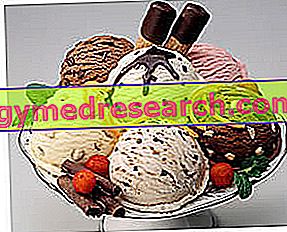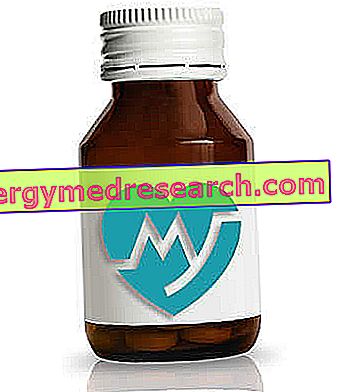This guide addresses the world of artisan gelato at 360 degrees, analyzing the theoretical and practical aspects to give the reader all the information needed to produce quality ice cream, directly at home and without the use of expensive machinery.

GENERAL INDEX
- What is ice cream
- Ice cream components
- Air (in-depth: the number of over-runs), Water and Solids
- Sugar in the ice cream
- Fats in the Ice Cream
- SLNG (Non-Fat Milk Solids) - calculate the percentage of SLNG
- Dry Residue of Gelato (Other Solids) - carob flour in ice creams
- Types of Ice Cream:
- Ice creams and sorbets
- Cream, cream and fruit ice cream
- Ice Cream Preparation
- Balancing of the mixture
- Pasteurization of the mixture
- Maturation of the mixture
- Creamy ice cream (chilling or freezing)
- Firming ice cream
- Prepare ice cream at home
- Final verification: Do the Quiz and Find out if you are a good Ice Cream Maker!
- Calorie del Gelato and Nutritional Aspects
- Gelato and Sorbet Video Recipes
What is ice cream
Ice cream is a complete, healthy and genuine food consisting of a suitably balanced mixture of sugars, fats, proteins, water and other accessory substances.
Through continuous freezing and stirring, the mixture gradually absorbs air, thickens and takes shape, reaching the characteristic consistency and softness of ice cream.
While in the past the ancestor of ice cream could only be a simple mixture of fruit juices, crushed ice (or snow) and wine, modern ice cream takes on a much more delicate and complex connotation at the same time.
In fact, preparing a good ice cream is not as immediate as it might seem. After careful balancing of the mixture, the ingredients can be transformed into a thick, spreadable and full-bodied cream only when some precise and distinct steps are fully respected. As we will deepen during the course of the discussion, in fact, the mixture requires pasteurization (heat treatment), followed in turn by a cooling period (maturation) which should be maintained for at least 6-12 hours. Only later, it is possible to proceed with the creaming of the mixture (preparation of the ice cream), therefore with the realization of the finished product.
The modern artisanal ice cream should not be considered a mere delicacy for children or a banal expedient to counteract the summer heat and heat: the ice cream is a complete, genuine food without contraindications.
Hazelnut ice cream
X Problems with video playback? Reload from YouTube Go to Video Page Go to Video Recipes Section Watch the video on youtubeIce cream components
The raw materials that make up the ice cream are ingredients that come from the animal or vegetable world: milk, cream, eggs, juices, sugars and water are in fact subjected to specific thermal and chemical processes which, in the finished product (ice cream), appear indistinguishable in a it is the only full-bodied, spatulable and velvety mass at the same time
Technically, we speak of a "mixture" to indicate the set of solid and liquid raw materials that make up the ice cream. When you work at low temperatures (<0 ° C), these components consolidate giving life to a new consistent and pasty shape that translates into structurally optimal ice cream, therefore in a quality finished product.
Ice cream consists of three main components: air, water and solids.
AIR
Air is an essential element that makes ice cream soft. During the mechanical processing phase (called freezing or freezing of the mass ), thousands of air microparticles naturally become incorporated in the mixture, giving volume and softness to the finished product.
Erroneously, it is customary to assume that the incorporation of air into ice cream represents a "fraud" device; in reality, air is, in ice cream, a very important raw material just like it is in shakes or whipped cream. It is an essential component like water and sugar in ice cream. When incorporated in a considered and precise way, in fact, the air gives the ice cream excellent qualities: it not only allows to obtain an extremely pleasant and soft structure, but also gives the ice cream a warmer sensation in the mouth, less icy.
Deepening: the number of overruns
To know the amount of air present in an ice cream, it is necessary to calculate the increase in volume of the mixture after its freezing, as well as the "overrun" of an ice cream.
By overrun is meant the ability of the mixture to incorporate air by simple mechanical agitation during the freezing phase. This capacity is expressed through a percentage number. In other words, the overrun is the increase in volume that the mixture acquires inside the batch freezers during the entire freezing phase.
To calculate the overrun of a mixture, the following formula must be applied:
| (mixture weight - ice cream weight) | x 100 = overrun% |
| ice cream weight |
Es.
The weight of the "milk base" mixture is 1.5 kg
The weight of the ice cream is 1.1 kg
The overrun is calculated as follows: (1.5-1.1) /1.1*100 = 36.4%
In general, the overrun of a "milk-based" ice cream should range between 30% and 40%, while a fruit-based ice cream should have an overrun of between 25% and 35%.
The overrun is indirectly proportional to the size of the ice crystals in the finished product: in other words, the higher the overrun, the smaller the size of the ice water crystals in the ice cream. Remember, however, that excessive overrun (> 35-40%) can favor the melting of ice cream.
WATER
Water is another essential element of ice cream, essential for the solubilization of the other components of the mass. Water, which occurs in ice cream in the form of ice microcrystals, is the wet part contained in each raw material and is the only element that can actually be frozen, able to solidify the mass.
So, theoretically, an ice cream could consist of the simple mixture of water, sugar and any flavorings: this would however involve the banal agglomeration of hundreds of thousands of ice crystals which, once stored in the freezer, would turn into an inevitable ice mass and solid.
To overcome this drawback, it is important to balance the mixture by adding other ingredients (eg milk, fat, solids, etc.) to water and sugar: in this way, the freezing point of the mixture drops from 0 ° C (temperature in which the water freezes) at -6 ° C / -10 ° C.
The addition of "anhydrous" substances to water - that is, of non-freezing and moisture-free ingredients such as powdered milk and sugar - is an indispensable condition for obtaining a quality product and minimizing the formation of coarse ice crystals in ice cream.
SOLID
The solids present in the ice cream mixture can be classified into 4 distinct categories:
- sugars
- fat
- SLNG (Non-Fat Milk Solids)
- Dry residue (often referred to as "other solids").
The table shows the main solids of the ice cream: for each of them, the most important functions are summarized and the problems related to their excess and lack in the mixture formulation are described.
| Solid | Types (main) | Function in ice cream | Problems related to excess | Problems related to a shortage |
| Sugars |
|
|
|
|
| Grassi |
|
|
|
|
| SLNG (lean part of the milk) |
|
|
|
|
| Other solids (or dry residue) |
|
|
|
|



